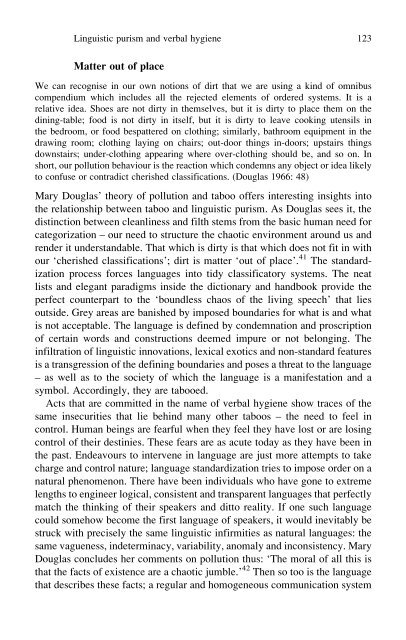Forbidden Words: Taboo and the Censoring of Language
Forbidden Words: Taboo and the Censoring of Language
Forbidden Words: Taboo and the Censoring of Language
Create successful ePaper yourself
Turn your PDF publications into a flip-book with our unique Google optimized e-Paper software.
Linguistic purism <strong>and</strong> verbal hygiene 123<br />
Matter out <strong>of</strong> place<br />
We can recognise in our own notions <strong>of</strong> dirt that we are using a kind <strong>of</strong> omnibus<br />
compendium which includes all <strong>the</strong> rejected elements <strong>of</strong> ordered systems. It is a<br />
relative idea. Shoes are not dirty in <strong>the</strong>mselves, but it is dirty to place <strong>the</strong>m on <strong>the</strong><br />
dining-table; food is not dirty in itself, but it is dirty to leave cooking utensils in<br />
<strong>the</strong> bedroom, or food bespattered on clothing; similarly, bathroom equipment in <strong>the</strong><br />
drawing room; clothing laying on chairs; out-door things in-doors; upstairs things<br />
downstairs; under-clothing appearing where over-clothing should be, <strong>and</strong> so on. In<br />
short, our pollution behaviour is <strong>the</strong> reaction which condemns any object or idea likely<br />
to confuse or contradict cherished classifications. (Douglas 1966: 48)<br />
Mary Douglas’ <strong>the</strong>ory <strong>of</strong> pollution <strong>and</strong> taboo <strong>of</strong>fers interesting insights into<br />
<strong>the</strong> relationship between taboo <strong>and</strong> linguistic purism. As Douglas sees it, <strong>the</strong><br />
distinction between cleanliness <strong>and</strong> filth stems from <strong>the</strong> basic human need for<br />
categorization – our need to structure <strong>the</strong> chaotic environment around us <strong>and</strong><br />
render it underst<strong>and</strong>able. That which is dirty is that which does not fit in with<br />
our ‘cherished classifications’; dirt is matter ‘out <strong>of</strong> place’. 41 The st<strong>and</strong>ardization<br />
process forces languages into tidy classificatory systems. The neat<br />
lists <strong>and</strong> elegant paradigms inside <strong>the</strong> dictionary <strong>and</strong> h<strong>and</strong>book provide <strong>the</strong><br />
perfect counterpart to <strong>the</strong> ‘boundless chaos <strong>of</strong> <strong>the</strong> living speech’ that lies<br />
outside. Grey areas are banished by imposed boundaries for what is <strong>and</strong> what<br />
is not acceptable. The language is defined by condemnation <strong>and</strong> proscription<br />
<strong>of</strong> certain words <strong>and</strong> constructions deemed impure or not belonging. The<br />
infiltration <strong>of</strong> linguistic innovations, lexical exotics <strong>and</strong> non-st<strong>and</strong>ard features<br />
is a transgression <strong>of</strong> <strong>the</strong> defining boundaries <strong>and</strong> poses a threat to <strong>the</strong> language<br />
– as well as to <strong>the</strong> society <strong>of</strong> which <strong>the</strong> language is a manifestation <strong>and</strong> a<br />
symbol. Accordingly, <strong>the</strong>y are tabooed.<br />
Acts that are committed in <strong>the</strong> name <strong>of</strong> verbal hygiene show traces <strong>of</strong> <strong>the</strong><br />
same insecurities that lie behind many o<strong>the</strong>r taboos – <strong>the</strong> need to feel in<br />
control. Human beings are fearful when <strong>the</strong>y feel <strong>the</strong>y have lost or are losing<br />
control <strong>of</strong> <strong>the</strong>ir destinies. These fears are as acute today as <strong>the</strong>y have been in<br />
<strong>the</strong> past. Endeavours to intervene in language are just more attempts to take<br />
charge <strong>and</strong> control nature; language st<strong>and</strong>ardization tries to impose order on a<br />
natural phenomenon. There have been individuals who have gone to extreme<br />
lengths to engineer logical, consistent <strong>and</strong> transparent languages that perfectly<br />
match <strong>the</strong> thinking <strong>of</strong> <strong>the</strong>ir speakers <strong>and</strong> ditto reality. If one such language<br />
could somehow become <strong>the</strong> first language <strong>of</strong> speakers, it would inevitably be<br />
struck with precisely <strong>the</strong> same linguistic infirmities as natural languages: <strong>the</strong><br />
same vagueness, indeterminacy, variability, anomaly <strong>and</strong> inconsistency. Mary<br />
Douglas concludes her comments on pollution thus: ‘The moral <strong>of</strong> all this is<br />
that <strong>the</strong> facts <strong>of</strong> existence are a chaotic jumble.’ 42 Then so too is <strong>the</strong> language<br />
that describes <strong>the</strong>se facts; a regular <strong>and</strong> homogeneous communication system

















